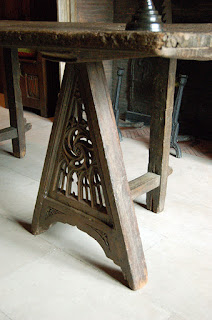There are only a few remaining medieval trestles: a set of four trestles can be found in Bruges, Belgium; another set is present in the Musee des Arts Decoratifs in Paris, France. My visit to this museum in April in order to see the trestles there was quite annoying, as the route through the museum was unclear, corridors connecting rooms were locked and the actual entrance happened to be on the third floor. Even more irritating was that most medieval items were displayed in a 'medieval bedroom' setting behind a rope (and stepping over it does sound the alarm). It was impossible to study the furniture from close-by - including the two trestles with their table top. Perhaps the curators did this to hide the fact that the medieval furniture on display looked quite worn and in a bad condition ...
The trestle table as found in the medieval bedroom in the Musee des Arts Decoratifs, Paris. While the two trestles look similar, there is some subtle difference in the rose pattern. Photo: Auction House Aguttes and Musee des Arts Decoratifs.

The trestle table in the bedroom. The worn and much used table top is of a later date and consists of one piece of oak.
On top are two brass candle-holders and a bronze mortar and pestle.
On top are two brass candle-holders and a bronze mortar and pestle.
The trestle table is only a recent acquisition of the museum. It was
bought at an auction in December 2010 for 29,040 Euro. The trestles are
made from oak, however the carved panels are made from chestnut. The
trestles were dated dendrologically to the late 15th century
(1473-1478). Both trestles look quite similar, but there is a slight
difference in the roses in the middle. A curious thing of these trestles is that one mortise and tenon is secured by a wedge. The only reason to do this would be that the trestle is collapsable, but this would mean that the other joints are loose too.
The left trestle and the right trestle. You can see a wedge securing the tenon of the lower horizontal stretcher in the mortise of the vertical beam.
Detail from the underside of the left trestle. The parts of the A are fixed by two wooden pins at each side.
The table top has a decorative plank added to the short sides.
Some more photos of the trestles.
According to the auction information, the trestle has a height of 86 cm, a width of 60 cm and a depth of 80 cm. I did some rough measurement at the Musee des Art Decoratifs, using the floor tiles and my hands as a guide, resulting in a slightly smaller size. Two photos were used to calculate the sizes of the different parts with the auction measurements as the basic measurement. The photos allow to measure the angle of the 'A', which was found to be 72 degrees.
Measurements of the medieval trestle of the Musee des Arts Decoratifs.
A low quality image of the backside of one of the trestles. This shows that the lower horizontal stretcher can only be connected to the 'A' with a hidden mortise and tenon fixed with a dowel. Though it is hard to see, the backside of the carved panel is flat.
Despite not being able to see the backside of the trestles myself, there was something else missing. One of my French furniture books also shows a photo of a medieval trestle from the Musee des Arts Decoratifs that has a quite different decoration. So there must be another medieval trestle, either in the depot or on loan to a castle (like Chateaudun) or another museum. One common thing is that they all look quite heavy and sturdy.
Another 15th century trestle from the Musee des Arts Decoratifs. Image scanned from 'Mobilier domestique volume 1. Vocabulaire - Typologie. Nicole de Reyniès. ISBN 9782858224616'. The decorated panel is held in a triangular frame, like the two trestles shown above.
To be functional, trestles have to have a table top. In the Musee the Cluny, also in Paris, is a folding trestle table top which is richly decorated. The table top originates from northern Germany and dates from around 1420. The table is 4.55 metres long and 76 cm wide. The painted motifs depict allegorical scenes of the 'virtues of princes'. Surrounding the scenes on the table are heraldic arms from Germany, Scotland and of Saladin shown as a representation of the known world. On the edge of the table is a frieze with foliar decoration and heraldic shields. A related folding table is found in Lüneburg, Germany.
The 4.55 metre long table needs six steel trestles to support it.
One of the hinges of the foldable trestle table top.
The stupidity of crowning an ass.
The judgement of Solomon.
9 photos covering the complete painted table top. Each scene is surrounded by heraldic shields and helmets.
This could be a dovetail where originally a trestle was inserted, fixing it to the table top.
There are more of these under the tabletop.
Two of the scenes inside a quatrefoil with the 'virtues of princes'. One depicts a king wondering about the four things that he does not know: the way of an eagle in the air, the way of a serpent upon a rock, the way of a ship in the midst of the sea, and the way of a man with a maid. The other one shows the fable of the lion and the rat.




































































